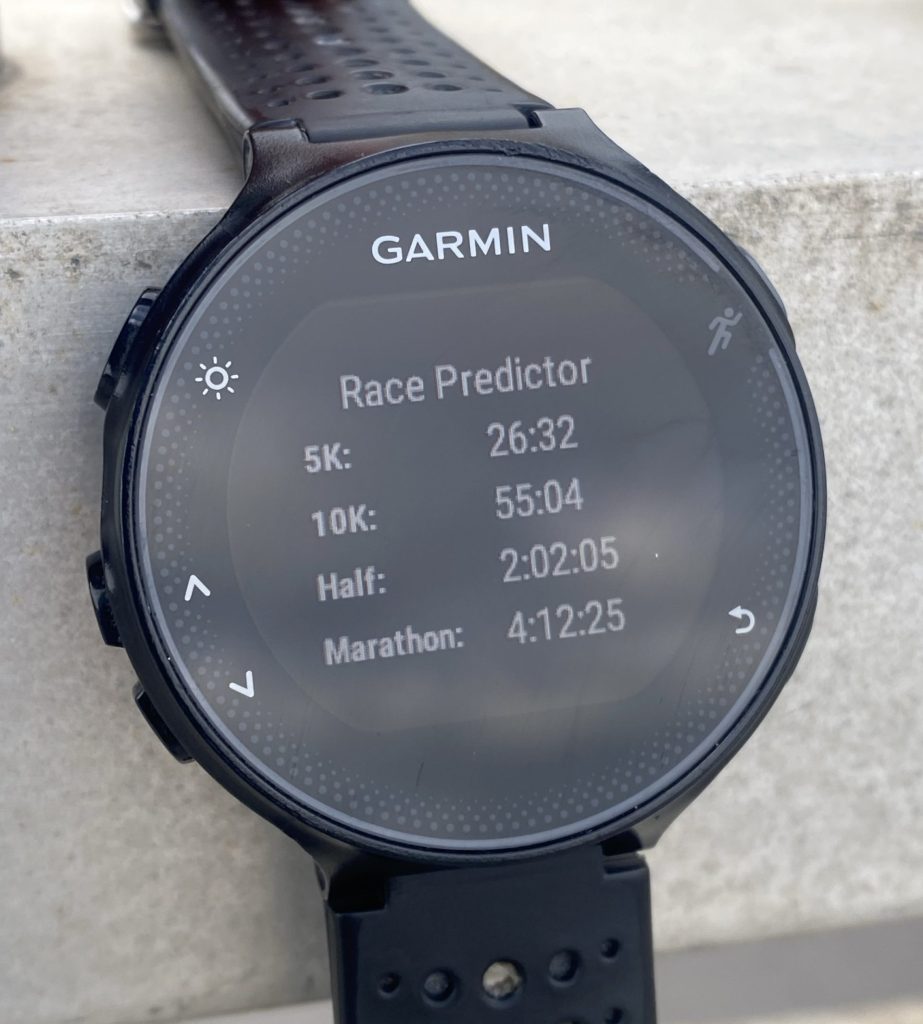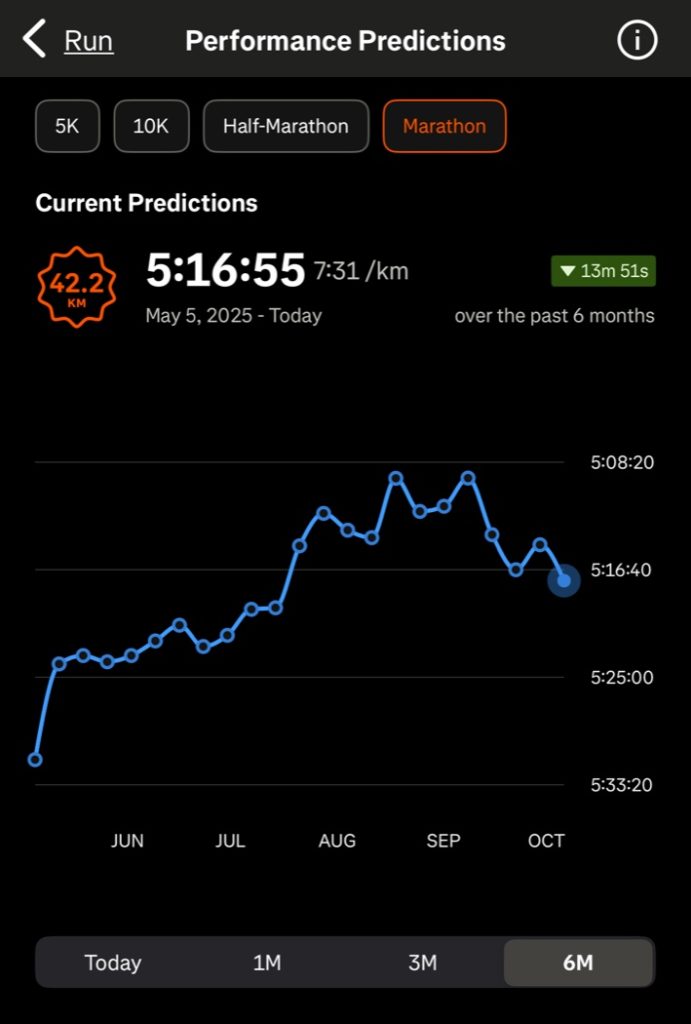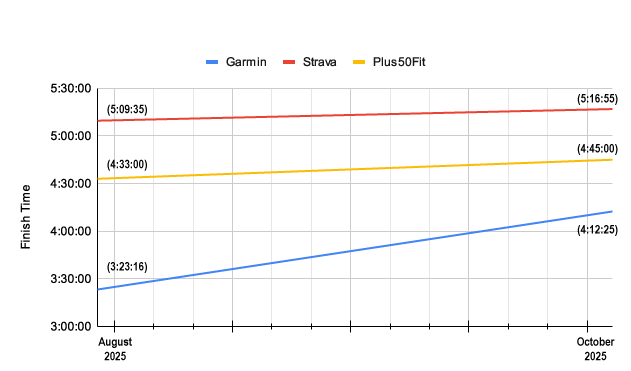Two Confident Algorithms, One Confused Runner
Garmin says I’ll finish my first marathon in 4:12:25.
Strava swears it’ll take 5:16:55.
They can’t both be right – and yet, they both think they are.
One uses physiology; the other uses patterns.
Both wear the crown of “AI prediction,” and both forget the one thing I never do: the long run.

When Algorithms Argue: Garmin vs Strava Race Predictor Accuracy
| Predictor | Predicted Marathon | Basis | Bias |
| Garmin (Forerunner 235) | 4:12:25 (5:58/km) | VO₂max correlation | Optimistic – ignores fatigue, fueling, and terrain |
| Strava (Performance Predictions) | 5:16:55 (7:31/km) | Training trend analysis | Conservative – underweights endurance and context |
| Plus50Fit Predictor | ≈ 4:45 (6:46/km) | rTSS/hrTSS, Pa:HR, fueling consistency | Effort-aware, context-honest, human-informed |
Garmin’s model extrapolates from lab-style data: short efforts, perfect rest, zero wind, zero stress.
Strava’s model watches your real-world performances – but not your intent. Those deliberately slow, steady Zone 2 runs? It reads them as limitations, not discipline.
And me? I’m right in the middle.
The Plus50Fit Predictor learns from both – but it remembers why I run the way I do.
The Downward Drift: When Strava Adjusted Its Math
Back in July, my Strava marathon prediction sat at 5:22:24.
By August, it tightened to 5:08, a nod to all those strong Build Phase sessions.
Then, curiously, by October – after months of consistent work – it lengthened again to 5:16:55.

Strava didn’t lose faith – it recalibrated.
In late 2025, Strava rolled out a new prediction engine based on user feedback, shifting more weight toward recent long runs and less toward peak short-distance fitness.
That’s great for capturing true endurance – but when your taper or Zone 2 block dominates recent history, it paints a slower picture.
Meanwhile, Garmin learned restraint.
It dropped my marathon prediction from a comical 3:41:03 in August to a more sober 4:12:25 today.
You could almost hear it saying, “Okay, maybe you’re not Kipchoge. But you’re steady.”
The Plus50Fit Predictor: Where Data Meets Discipline
Neither Garmin nor Strava accounts for what I call Effort Integrity – the context behind every run.
That’s where the Plus50Fit Predictor was born:
a model that weights effort over ego and factors in what runners after 50 know best – consistency trumps intensity.
It blends:
- rTSS/hrTSS Ratio: how pace and heart rate stress diverge over effort duration.
- Pa:HR (Aerobic Efficiency): how stable heart rate remains at given paces.
- IF (Heart Rate & Pace): intensity factor convergence – the sweet spot between aerobic control and output.
- Cadence Consistency: maintaining rhythm even under fatigue.
- Fueling Strategy: the unsung hero – Maurten 160, SaltStick tabs, hydration discipline, and mid-race restraint.
It doesn’t claim perfection. It claims perspective.

AI vs. Aging Gracefully
Garmin’s math doesn’t know how old I am – not really.
Strava’s trendlines don’t see my pre-run fueling, my mantra repetitions, or my low-Z2 discipline.
Neither knows the runner who shows up rain or shine, fueled on purpose and curiosity.
That’s where the Plus50Fit Predictor wins. It doesn’t ignore fatigue – it interprets it.
It doesn’t panic when my pace slows during taper – it understands why.
It knows that long-run durability, not short-run sparkle, defines marathon success.
Garmin uses math. Strava uses trends. I use truth – the kind you can only earn one kilometer at a time.
For the Curious (and the Cosy Data Lovers)
If you love a graph as much as a sunrise run, check out these related reads in the Predictor Trilogy:
- 🧭 Why Are My Garmin and Strava Race Predictors So Far Off? I Asked AI
- 🕹️ Garmin Race Predictor vs Reality
- 💭 Thought of the Day: Race Predictor Gap
And if you’re a data nerd with a heart – you’ll want to follow what’s coming next:
Plus50Fit Predictor v1.0 – your own effort-aware calculator for honest race estimates.
The Takeaway
Running teaches patience.
AI teaches probability.
Between them, I’ve found something more human – a space where math meets meaning. So when Garmin says I’m faster than I feel, and Strava says I’m slower than I hope,
I just smile, lace up, and let the road decide.

[…] Forerunner 235 showing 4:12:25 predicted marathon time. Strava Race Predictor showing 5:09:35 predicted marathon […]